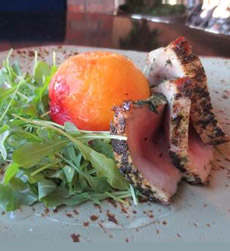RECIPE: Seared Tuna With Roasted Peaches
 It’s not an orange: It‘s a roasted peach, served with grilled ahi tuna. Photo courtesy Waterbar | San Francisco. |
Peach season in the U.S. lasts from May through August or early September, thanks to the different zones and climates where they are grown. In the cooler weather states, the harvest starts later but lasts into September and even October.
Here‘s one for roasted peach with seared ahi tuna. You can substitute any seafood, poultry, pork, even lamb. The recipe is from Parke Ulrich, Executive Chef of Waterbar in San Francisco. |
|
|
This recipe has a special significance for Chef Parke. Each year he participates in the Adopt-A-Tree program from Masumoto Family Farm, which grows the organic Elberta peaches for his dishes. They are harvested in late July or early August. Chef Parke then creates dishes using the peaches in the month of August. See more about Elberta peaches below. Plan a visit to Waterbar. Perched on the water’s edge, with one of the most extraordinary views of the San Francisco Bay, the Bay Bridge, the famed Ferry Building and the Embarcadero skyline, the seafood is as good as the view. The restaurant is open for lunch and dinner daily. Ingredients For 4 Servings |
||
|
Preparation 1. SCORE the bottom of each peach (opposite the stem end) with a small X. Place a ½ inch layer of rock salt in the bottom of a sauté pan. Place the peaches stem end down in the salt. 2. SLOW ROAST the peaches at 300°F until they are tender to the touch (approximately 7 minutes, depending on ripeness). Let cool. Remove the skin and reserve the peaches for plating. 3. POUR vinegar into a non-reactive saucepan. Reduce by ¾ and chill. When the vinegar is cool, the consistency should be like syrup. If it is too thick, thin it out with Champagne vinegar. Reserve for plating. 4. SEASON the tuna with salt and pepper. Let sit for 10 minutes until the tuna starts to sweat. Place finely chopped basil on a sheet tray. Once the tuna is moist, roll the tuna in the chopped basil, crusting it. 5. SEAR the tuna on all sides in a sauté pan on medium-high heat. Be careful not to burn the basil. Cook the tuna to medium rare. |
 Eberta peaches. Photo courtesy Gurneys.com. |
|
|
6. TO SERVE, split the peaches in half and remove the pits. Place arugula equally in the base of 4 bowls. Place peach half on top of the arugula nest. Slice the tuna into 8 pieces. Lay tuna over the peach. Drizzle with the balsamic reduction. ABOUT AHI TUNA Ahi can be a confusing term. It us the Hawaiian word for the bigeye tuna (Thunnus obesus), but is also used in restaurants to refer to the related yellowfin tuna (Thunnus albacares). Bigeye tuna are amongst the tuna species most threatened by overfishing, so go for the yellowfin if you can distinguish it. Here are the main species of tuna. The Elberta variety was once the most popular of peaches in the U.S., a yellow freestone peach with creamy flesh, juicy and ideal for eating, canning and freezing. Named for the wife of the Georgia peach grower who identified the hybrid in the 19th century, the Elberta began to be phased out after World War II as newer peach varieties were developed and introduced by university experimental agricultural stations. [Source] These hybrids traveled better than the Elberta and were more durable at supermarkets. Heirloom Elbertas are still grown, and can be found in farmers markets. Wild peaches originated in China, and have been cultivated there since at least 1000 B.C.E. Here’s the history of peaches. |
||


